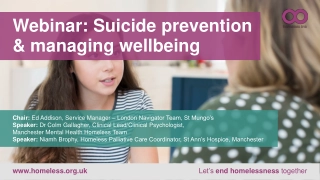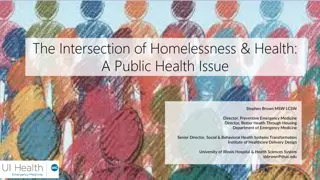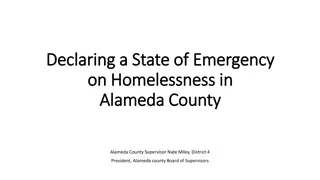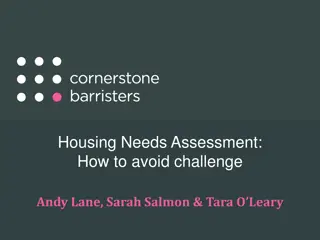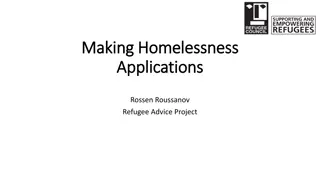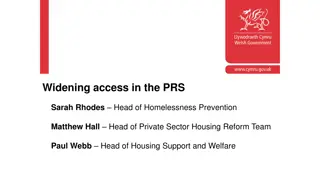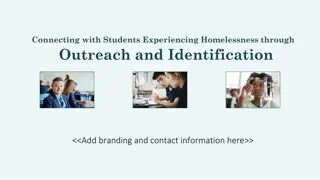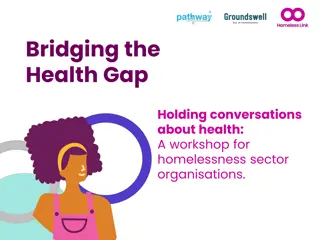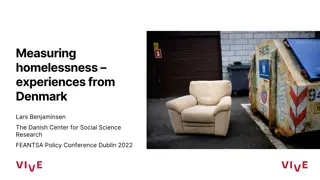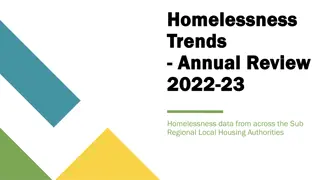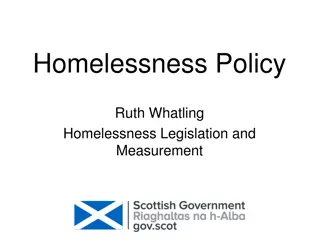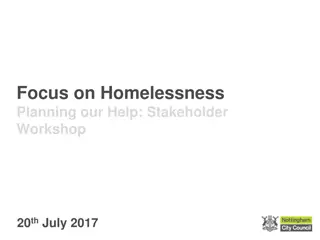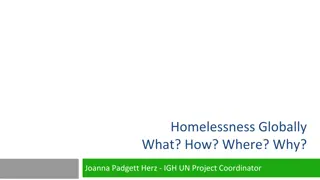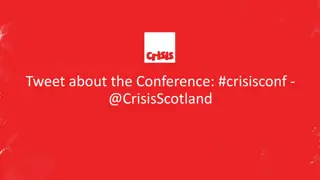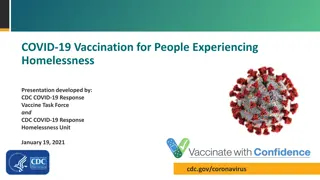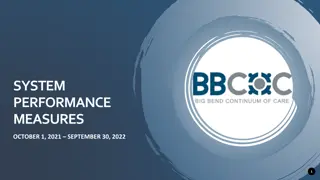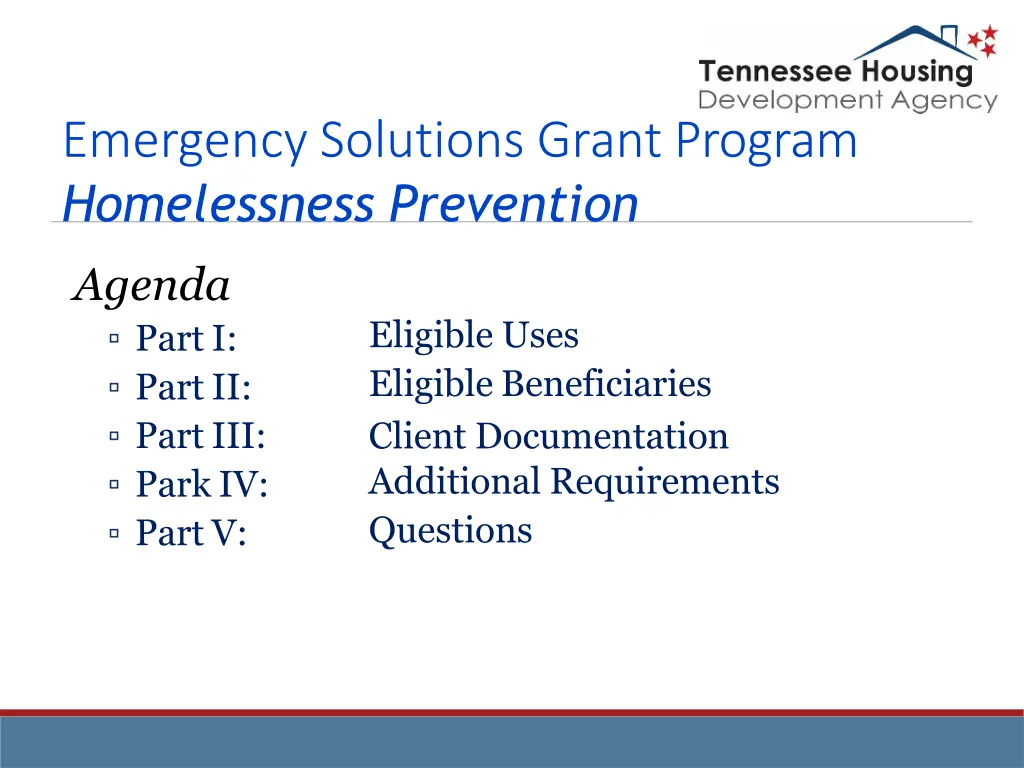
Emergency Solutions Grant Program Eligible Uses
Learn about the eligible uses of the Emergency Solutions Grant Program, including housing relocation and stabilization services, rental assistance, housing search and placement, case management, legal services, and more. Understand how this program aims to prevent homelessness by providing necessary support and financial assistance to individuals and families in need.
Download Presentation

Please find below an Image/Link to download the presentation.
The content on the website is provided AS IS for your information and personal use only. It may not be sold, licensed, or shared on other websites without obtaining consent from the author. If you encounter any issues during the download, it is possible that the publisher has removed the file from their server.
You are allowed to download the files provided on this website for personal or commercial use, subject to the condition that they are used lawfully. All files are the property of their respective owners.
The content on the website is provided AS IS for your information and personal use only. It may not be sold, licensed, or shared on other websites without obtaining consent from the author.
E N D
Presentation Transcript
Emergency Solutions Grant Program Homelessness Prevention Agenda Part I: Part II: Part III: Park IV: Part V: Eligible Uses Eligible Beneficiaries Client Documentation Additional Requirements Questions
Homelessness Prevention CFR 576.103 Intended to provide rental assistance and housing relocation or stabilization services necessary to prevent an individual or family from moving into an emergency shelter, living on the streets, or a place not meant for human habitation
Eligible Uses Housing Relocation and Stabilization Services Financial Assistance Rental Application Fees When charge by owner to all applicants SecurityDeposits Equal to no more than 2 month s rent Last Month sRent Applies to 24-month cap UtilityDeposits When required by utility company for all customers UtilityPayments Up to 24 months of payments per service, including up to 6 months of arrears per service MovingCosts Cost of truck rental, moving company, up to 3 months of storage
Eligible Uses Housing Relocation and Stabilization Services Services Housing Search andPlacement Up to 30 days during the period the program participant is literally homeless and seeking housing Housing Stability Case Management Up to 24 months Mediation LegalServices CreditRepair
Eligible Uses Rental Assistance Tenant-Based orProject-Based Short-term rental assistance 0-3 months Medium-term rental assistance 4-12 months RentalArrears One-time payment for up to 6 months of rent in arrears Up to 24 months of rental assistance may be provided during any 3-year period, including a one- time payment of rental arrears
Eligible Uses AdditionalRequirements Rental assistance cannot be provided to a program participant that is receiving Tenant-Based Rental Assistance or living in a unit receivingProject-Based Rental Assistance or operating assistance through other publicsources Exception applies to rental arrears on tenant s portion of rentalpayment Utility assistance should not be the primary assistance provided, but should be provided as part of an overall stabilityplan Only provided when housing has been identified Other utility assistance available within the community should utilized first before ESG funds are utilized
Eligible Beneficiaries Homelessness Prevention Targeted to individual and families at risk of homelessness Available to persons below 30 percent of AMI and homeless or at risk of becominghomeless To prevent household from becoming homeless and to regain stability in current or other permanent housing
Eligible Beneficiaries Initial Evaluation Individual or family who meets Category 2, Category 3, or Category 4 of HUD s Homeless Definition OR Individual or family who meets one of the three categories of HUD s At Risk of Homelessness Definition AND Has an annual income below 30 percent of median family income forarea
HUDS Homeless Definition Category 2 - Imminent Risk of Homelessness Individual or family who will imminently lose their primary nighttime residence, provided that: Residence will be lost within 14 days of the date of application for homeless assistance; No subsequent residence has been identified; and The individual or family lacks the resources or support networks need to obtain other permanent housing Category 3 - Homeless Under Other Federal Statues Unaccompanied youth under 25 years of age, or families with children and youth, whodo not otherwise qualify as homeless under this definition, but who: Are defined as homeless under the other listed federal statues; Have not had a lease, ownership interest, or occupancy agreement in permanent housing during the 60 days prior to the homeless assistance application; Have experienced persistent instability as measured by two moves or more during in the preceding 60 days; and Can be expected to continue in such status for an extended period of time due to special needs or barriers Category 4 - Fleeing or Attempting to Flee DV Any individual or familywho: Is fleeing, or is attempting to flee, domestic violence; Has no other residence; and Lacks the resources or support networks to obtain other permanent housing
HUDs At Risk of HomelessnessDefinition Category 1 Individuals andFamilies An individual or familywho: Has an annual income at or below 30 percent of median family income for the area; and Does not have sufficient resources or support networks immediately available to prevent them from moving to an emergency shelter or another place defined in Category 1 of the homeless "definition; and Meets one of the followingconditions: Has moved because of economic reasons 2 or more times during the 60 days immediately preceding the application for assistance;or Is living in the home of another because of economic hardship;or Has been notified that their right to occupy their current housing or living situation will be terminated within 21 days after the date of application for assistance;or Lives in a hotelor motel and the costis notpaid forby charitableorganizationsor by federal, state,orlocal government programs for low-income individuals;or Lives in an SRO or efficiency apartment unit in which there reside more than 2 persons or lives in a largerhousing unit in which there reside more than one and a half persons per room;or Is exiting a publicly funded institution or system or care;or Otherwise lives in housing that has characteristics associated with instability and an increased risk of homelessness, as identified in the recipient s approved Con Plan Category 2 Unaccompanied Children andYouth A child or youth who does not qualify as homeless under the homeless definition, but qualifiesas homeless under another federalstatue Category 3 Families with Children andYouth An unaccompanied youth who does not qualify as homeless under the homelessdefinition,but qualifies as homeless under the McKinney-Vento Homeless Assistance Act, and the parent(s)or guardians(s) or that child or youth if living with him or her
Eligible Beneficiaries Re-Evaluation of Eligibility Program participants must be re-evaluated at least once every three months Eligibility: Program participant does not have an annual income that exceed 30 percent of median family income for thearea Program participant lacks sufficient resources and support networks necessary to retain housing without ESGassistance Types and amounts of assistance
Client Documentation Forms Each documentation requirement must be met, whether a form is provided ornot Agency is able to create own forms as longas the documentation requirement is met
Client Documentation Intake Documentation Documentation of ID for all program participants 18 andolder Documentation of Social Security Number for each programparticipant
Client Documentation EligibilityDocumentation Documentation of initial evaluation to determine the eligibility of each individual or family s eligibility for ESG program Documentation of homeless status or at-risk of homelessness status Documentation of annual income Documentation of re-evaluation of participant s eligibility Documentation of ineligibility for each individual or family determined ineligible for ESG program
Client Documentation Housing Documentation Lease Rental assistance agreements for the provision of rental assistance Documentation of rent reasonableness and fair market rent for all housing units Documentation of compliance with housing standards
Client Documentation Assistance Documentation Documentation of client need for assistance Eviction notice, utilitystatements Documentation of types of services and/or assistance provided and amounts spend on services and/or assistance Documentation of payments made to owners for provision of rental assistance
Client Documentation Assistance Documentation Documentation of services andassistance provided to each programparticipant Documentation that the provision of services or assistance are eligible under the program component Documentation of compliance with termination of assistance requirement Documentation of use of local coordinated entry system, as available
Client Documentation Case Management Documentation Documentation of case management services Documentation of housing plan for stability in permanenthousing Documentation of connecting participants to mainstream and other resources for supportive services
Additional Requirements CaseManagement Assistance through ESG is intended to be provided as a part of a system-wide approach Develop a plan with each program participant on how they will retain permanent housing after the ESG assistance ends Require program participants to meet with a case manager not less than once per month while they are receiving ESG-assistance to implement the plan and monitor progress towards housing stability Exemption from this requirement if agency also receives funding under the VAWA orFVSP Assist program participants in obtaining appropriate supportive services, as well as connecting them to other federal, state, local, and private benefits and services for which they may be eligible Have written polices and procedures for coordination among different providers of services in the community Case management is required for any type of assistance
Additional Requirements Case Management Case management services should be directedtowards address the housing stability needs of clients Should include goal planning, prioritization of client needs, clientprogress Documentation of client services must be included in client files to show how agency is addressing the needs of clients and progress towards housing For clients protected by VAWA, case management can not be required to receive assistance, but it isrequired that the program offer services to clients and document frequent efforts of offeringservices
Additional Requirements Rent Reasonableness and Fair Market Rent Housing unit must not exceed the Fair Market Rent (FMR) established by HUD for each geographic area and comply with HUD s standard of rent reasonableness RentReasonableness Ensure that rents being paid are reasonable in relation to rents being charged for comparable unassisted units in the same market Fair Market Rent Determined payment standards or rent ceilings for HUD- funded programs that provide rental assistance Gross rent = rent + cost of utilities
Additional Requirements Rental Assistance Agreements Between the agency and property owner Sets the terms under which the rental assistance is being provided A provision requiring the owner to give the agency a copy of any notice to the program participant to vacate the housing unit, or any compliant used under state or local law to commence an eviction action against the program participant The same payment due date, grace period, and late payment penalty requirements as the program participant s lease The agency should establish the term of the rental assistance agreement for the period of time they anticipate providing assistance
Additional Requirements Rental Assistance Agreements Should include provisions addressing: Type of rental assistance being provided Late payments Program participant sharing in rent Termination When assistance for rental arrears is provided, the agreement should provide the amount paid by the agency, include the number of months of arrears paid, any other terms and conditions of the payment, and should reflect the evidence/documentation used to justify that the arrears are an eligible payment
Additional Requirements LeaseAgreements Each program participant receiving rental assistance must have a legally binding, written lease for the rental unit, unless the rental assistance is provided solely for rentalarrears Must be between the program participant and the owner When assistance is provided solely for arrears, an oral lease agreement may be accepted in place of a written lease, if the agreement gives the program participant an enforceable leasehold interest under state law and the agreement and rent owed are sufficiently documented by the owner s financial records, rent ledgers, or cancelledchecks
Additional Requirements Habitability Standards When using ESG funds to help a program participant remain in or move into housing,must ensure that it meets the minimum habitability standards Housing unit must be inspected before providing services or assistance
Additional Requirements Prioritization Individuals and families with the greatest need receive priority for any type of assistance available Grantees should have prioritization policy in place which outlines the process by which the agency will prioritize the most in need ofservices Policies should be in place in order to ensure that ESG funding is being utilized in the most effective service provisionmethods
Additional Requirements Coordinated Entry Participation 24 CFR 576.400(d) Each local continuum of care is required to develop and/or operate a centralized or coordinated intake or assessment system if any agencies in the continuum of care receive federal funding Sub-recipients must participate in the coordinated entry for their CoC If there is not yet a centralized intake, a sub-recipient must participate in its implementation and eventually its use If CoC has identified an intake tool for the community, agency must utilize as applicable
Additional Requirements Resource Coordination 24 CFR 576.400 (b) and (c) Coordination with homeless services and mainstreamresources Grantee will assist homeless individuals in obtaining permanent housing, appropriate supportive services, and other federal, state, local, and private assistance available for suchindividuals Documentation of coordination efforts must be included in clientfiles
Contact Information Please submit all questions to esg@thda.org

